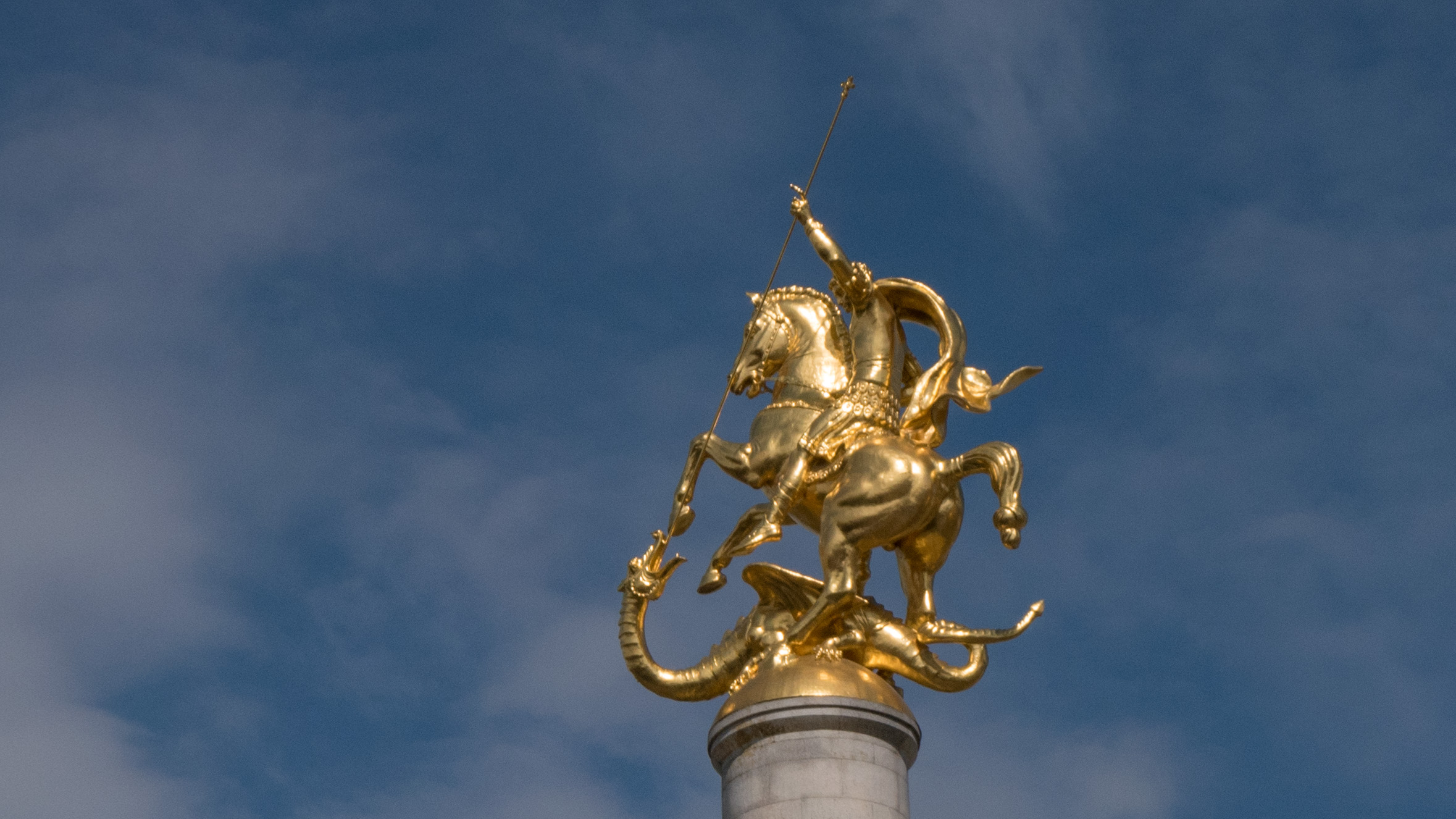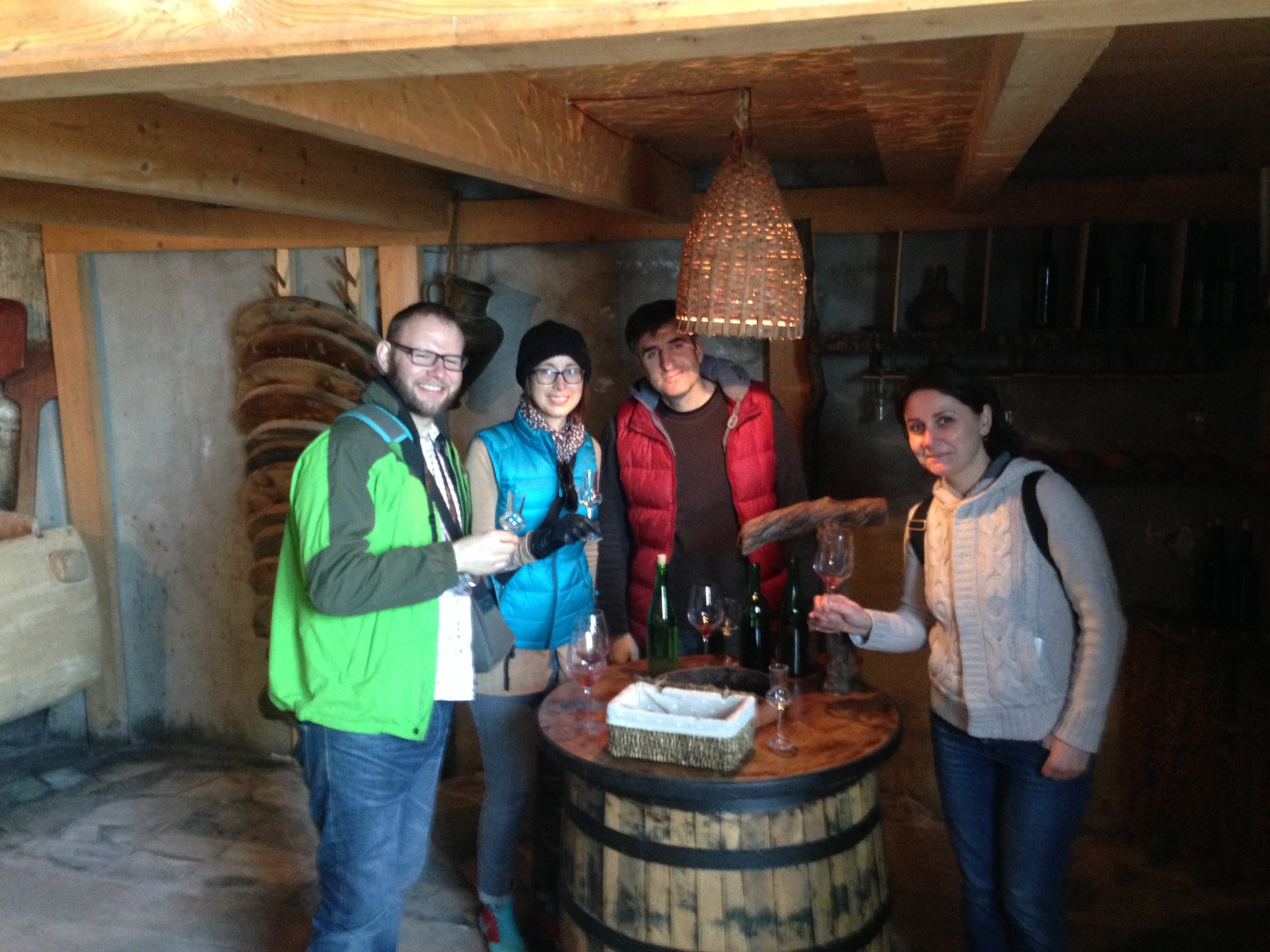Shabby Chic in Tbilisi
Destination: Tbilisi, Georgia
Dates: 30. March 2016 - 4. April 2016
Reason for Travel: Pleasure/Friends
Modes of Transport: Plane (Turkish), Taxi, Arranged Tours
It's amazing to think about where you'll end up someday. The country of Georgia is one such place. I had hardly ever given it a second thought and never would have imagined visiting it. The only things I knew about the country on the Eastern shores of the Black Sea was where it was, that it was a former Soviet Republic and that Russia had invaded it in 2008. (Note: Russia continues to occupy Ossetia and Abkhazia). I also once taught a man who was married to a Georgian.
St. George slaying the dragon.
Our trip to Georgia was thanks to two factors. First, Elizabeth had a work trip to Istanbul and would be "in the area," and two she had a friend working there. These two factors combined to make the trip a seeming no-brainer for us and on an evening in February 2016 we booked tickets from Zurich to Istanbul and then to Tbilisi. The additional flight to the Georgian capital was surprisingly inexpensive. On Wednesday, March 30, 2016 we took off from Ataturk Airport (IST) and flew over the Southern part of the Black Sea and landed at Shota Rustaveli Tbilisi International Airport (TBS). The flight lasted all of two and a half hours, but we flew back an extra time zone. From the airport, we were picked up by a chauffeur we'd arranged with our Airbnb host, Hans. Hans is a German tech entrepreneur and TEDster, who through the course of his travels had developed a fondness for Georgia and along with buying a flat in the Tbilisi also had a kiwi plantation, from which he produced honey. He left us a jar of the honey as a present. When we arrived in the flat, it was freezing, but during the course of the evening the heater kicked in and it became quite pleasant. The flat itself had extremely high ceilings and large windows. It was very nicely done, though, from the entry and the halls of the building, one would have thought we were staying in a criminal and drug infested dive. Though I have no proof of this, I believe that the building still carries a great deal of its Soviet past. Several flats share bathrooms and it looks like the once large flats in a once noble building were divided up into smaller units to house more people. Think about that scene in Dr Zhivago, where he comes back and is told that in his house there was enough living space for thirteen families. Anyway, our flat in Tbilisi was nice with all of the amenities.
The next day we walked around the town to just discover it on our own. One of the things that you'll quickly notice is that everyone goes to church and they'll make a pious gesture when passing a church. The city is a brilliant blend of old European styles of architecture fitting Berlin or Vienna, dilapidated old buildings and futuristic constructs that seem both out of place, yet provide an interesting juxtaposition to everything else. You're left wondering if there is an artistic and thought provoking commentary with the new buildings, or if a dictatorial overlord went on a spending spree on his flights of fancy. We quickly learned that former president Mikheil Saakashvili had started many building projects with German architect Jürgen Mayer-Hermann and Italian architect Michele De Lucchi, the latter of which designed Tbilisi's most iconic landmark the Peace Bridge. What was a shame to hear was the concert hall, which looks done from the outside was never finished, because the government that took control after Saakashvili's electoral loss in 2013 decided to scrap all of his enthusiastic projects. If you enjoy architecture though, you'll really like Tbilisi and Georgia.
The next day we went on a wine tour of the area. Georgia claims to be the birth place of wine and there is a reason for it, they have some of the oldest vineyards in the world and a very old wine making tradition. Unlike the European wine tradition, traditional Georgian wines are made in clay jars called Kvevri. The grapes are crushed (often still by foot) and the juice and skins are filled into the Kvevri, which are in the ground and then capped. Over 5-6 months, the skins settle to the bottom and naturally filter the wine. The result is a wine that, from the ones we tried, tends to have higher acidity and with reds much higher tannins than Italian, French or American wines. If you're not used to it, you'll probably hate the first glass, but we tried lots and gained an appreciation for it. If you like natural wines or orange wines, you'll like these from the start. Our wine tour took us from a monastery where women are not allowed to be present when the wine is made to a chateau producing French style wine finally a small family production that has been winning international acclaim. Our only recommendation for others taking the wine tour would be to bring extra water and food. The tour guide though was excellent and gave us a wealth of information.
The next day we continued our gastronomic adventure with a Culinary Backstreets tour. Little did we know that we were on the inaugural tour in Tbilisi. Our guide, Paul, was an American writer and musician who through a number of twists and turns in his life ended up in Tbilisi, a city he loves so much that he and his wife bought a house there. On the tour with us were two reporters from Berlin, though they were actually British nationals, as well as a Georgian lady training to be a guide. We started in a traditional bakery where the wafts of fresh bread from the wood-fired clay ovens seduced us. Each day the locals line up for the fresh semi-unleavened breads, Khachapuri, and other delicious treats. From there we went on to the market, where we got to try everything from the local cheeses to cured meats, fresh vegetables and seasonal fruits. It wouldn't have been a proper food tour in Georgia without a stop off for some Khinkali. After stuffing our faces with these succulent dumplings, we went on to a multi-course food extravaganza in an eclectic yet family-friendly restaurant in the neighbourhood of Sololaki, where our Airbnb also happened to be. Our meal was rounded off with a shot of Cha-Cha, the Georgian take on grappa but with more fruit notes.
Our last day in Tbilisi was spent taking in the city some more. We walked through the flea market, rich in Soviet and Stalin memorabilia. It was also here that we got Cha-Cha ambushed by a group of older men. A Cha-Cha ambush is when you are unexpectedly asked or rather politely forced to have a drinking session of Cha-Cha with friends or strangers. Alcohol is a big part of this pious country's culture. We witnessed this during the church service we attended to listen to the polyphonic singing. I'd never been in a church with so many parishioners - the church was so full that you were always touching someone and there were no seats, they still stand. From communion onwards, the wine jug was passed around with many having more than just a ceremonial sip of the blood of Christ. They also helped themselves to more than a nibble of his body as the bread bowl was also passed around. Though with the service lasting over three hours, I could see how the people might get hungry.
Our Cha-Cha ambushers
A very pious country.
In the afternoon, we went to Tbilisi's famous sulphur baths. Legend has it that King Vakhtang I Gorgasali of Georgia founded Tbilisi after hunting in the heavily wooded region with his falcon. His falcon caught a pheasant and fell with its prey into a nearby hot spring and died from burns. Despite the loss of his falcon, King Vakhtang became so obsessed with the hot springs that he decided to cut down the forest and build a city on the location. The city also derives its name from the hot springs: T'bilisi (თბილისი) literally means "warm location." Today these hot springs are covered by domed structures, many clustered together and run as a private spa. We booked a session in one of them. What we got was a private room and a separate room with a large tub filled with hot spring water that seeped out of the rock, a shower and a large stone table for scrubbing. The treatment we got from our bath assistant was both vigorous and invigorating. After we were thoroughly scrubbed, washed and rinsed and relaxing in the hot tub, our bath assistant stripped down and showered in our room. I do not think there was anything perverted about this, but it was an odd experience and I don't think it is the standard in the other houses.
The roofs of the sulphur baths
The afternoon we spent going to a photography exhibition, having drinks at PurPur, one of Saakashvili's former haunts, when he was president. The atmosphere is fantastic with a deep crimson wall decorated with dried flowers and shabby-chic furniture. It will remind you of many places in East Berlin after the wall came down. However, in Tbilisi, this is a place to see and be seen. After our drinks, we went to Culinarium for dinner. The restaurant specialised in a fusion of Georgian and Asian cuisine and was amazing, as was their wine selection. It was also featured in season 7, episode 5 of Anthony Bourdain's "Parts Unknown."
If you love great food that stands out from most other European cuisines, appreciate architecture, and an interest in former communist countries and want to explore a country a little off the beaten track, Georgia is a gem and a place we would visit again at the drop of a hat. One of our biggest wishes would be for an entrepreneurial Georgian to open a restaurant in Zurich.





































